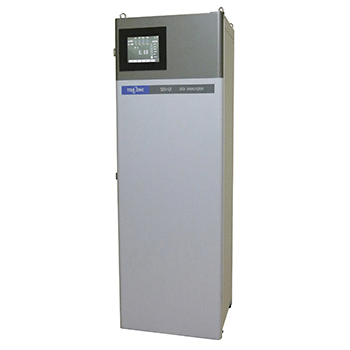
The SDI-12 Analyzer measures fine suspended solids (colloidal particles) in water and calculates the Fouling Index (FI), also known as the Silt Density Index (SDI). This method is used to monitor water treatment plants such as filters and reverse osmosis systems. Until now, the determination of the SDI had to be carried out semi-automatically or manually. With the fully automatic system, new levels of quality and precision can be achieved.
The device operates according to an automated measurement principle: water is passed through a filter over a defined period of time to collect particles. Subsequently, the clogging of the filter is measured using a high-precision flow meter.
The SDI-12 relies on advanced flow measurement that uses a precise sensor to detect resistance in the filter. This technology allows early detection of blockages and appropriate measures to be taken to optimize water quality. Continuous monitoring minimizes downtime and significantly reduces maintenance efforts.
The SDI-12 offers automatic SDI measurement for continuous water monitoring. The high-precision flow meter ensures accurate measurement results and enables early detection of blockages. Thanks to the user-friendly touch panel, operation is particularly intuitive. In addition, the long-lasting filter cartridges are low-maintenance and ensure reliable performance. The device is ideal for industrial water treatment and quality control.
The SDI-12 Analyzer is used in various areas, including:
The SDI value (Silt Density Index) is a crucial quality indicator for the feed water of reverse osmosis (RO) systems. It provides information about the amount of fine particles and colloidal contaminants in the water – precisely those substances that can heavily stress and block RO membranes. A too high SDI value leads to frequent cleaning cycles, shorter membrane lifetimes, and increased operating costs. For this reason, the SDI value is a central parameter in water treatment and pretreatment. For stable and economical operation, SDI values below 5 are recommended – optimal are values below 3. Continuous monitoring of this value contributes significantly to the longevity and efficiency of your RO system.
The measuring device captures the Silt Density Index (SDI), also known as the Fouling Index, to determine the amount of suspended solids in water as accurately as possible. This method is based on a standardized filtration where water flows through a 0.45 micron filter membrane at constant pressure. Simultaneously, the device measures the flow rate both at the beginning and after a set time period – for example, after 5, 10, or 15 minutes.
If the flow rate decreases over time, the SDI value increases. This means that more and more particles are accumulating in the membrane and clogging the filter. A high SDI value signals an increased risk of fouling in reverse osmosis systems as well as in other water treatment systems. For this reason, modern SDI analyzers optimize the entire measurement process by fully automating it. This not only produces precise but also reproducible values. In addition, continuous water quality monitoring allows for early detection of potential problems, so that appropriate measures can be taken immediately.
© All Rights Reserved
Gerne beantworten wir Ihnen Fragen zu unseren Produkten oder schicken Ihnen ein Angebot zu. Alternativ schreiben Sie bitte an info@upm-gmbh.de
We would be happy to answer any questions about our products or send you a quote. Alternatively, please write to info@upm-gmbh.de